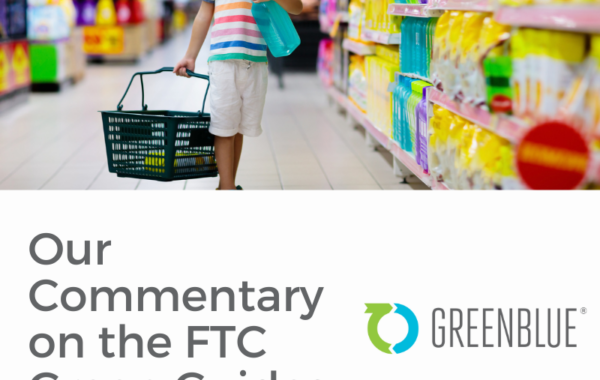April 18, 2019
The SPC & The Center for the Circular Economy at Closed Loop Partners team followed up with Richard Daley, Managing Director of RenewELP, for a post challenge interview.

From left: Adam Gendell (SPC), Tristanne Davis (SPC), Richard Daley (RenewELP), Kate Daly (Closed Loop Partners)
Q: How did you find out about the FlexPack Recovery Challenge and what made you want to apply?
We became aware of the challenge via Unbuntoo, a corporation which connects innovators and industry leaders. Our technology sounded like an ideal candidate for the competition so we made the decision to apply.
We believed the competition could provide a fantastic opportunity to promote our technology to key players in the plastic packaging value chain. We also recognized the potential for international exposure which could lead to increased market awareness of our technology and help raise the profile of the Chemical Recycling Industry in general.
Q: Tell us about RenewELP’s business model in your own words.
ReNew ELP is seeking to change the way that the world views plastic waste. Instead of a waste product, which is either buried of or burned, plastic waste should be viewed as a resource, that can contribute to a low-carbon, low-waste society, and has the ability to stimulate the growth of a new Industry Sector (Chemical Recycling). The model works on the principle that we can create valuable products from a waste feedstock, which has little or negative value to suppliers, therefore making high returns which offset comparatively low processing costs.
Whilst we have been developing the commercial plant design, a core focus has been on establishing the company’s ability to expand beyond the first facility. In addition to the Wilton site, the company is seeking to build a pipeline of development projects in the UK and Europe. The fundamental business model is to license the technology once the initial plant has been proven at a commercial scale, allowing for a global expansion and discussions on future sites are already ongoing with potential partners and developers.
Q: How would you describe RenewELP’s CAT-HTR technology to someone without a technical background?
In simple terms, the technology takes in end of life plastic waste, which is then heated and pressurised and mixed with water (steam) in the reactors to break down the plastics into liquid oils and chemicals. The mixture is then depressurized and the products are separated and stored ready for transport to customers. It is a simple process and one of the novel aspects of the technology is that it uses water to break down the plastics into liquid products.
Q: What is Renew ELP’s environmental value proposition?
ReNew ELP can help drive toward a circular economy, sustainably converting waste plastic which cannot otherwise be recycled into high value oils and chemicals. These products have many end applications, one of which being as a feedstock to create virgin plastics. With our process, there is no limit to the number of times the plastics can be recycled and converted back into more plastics creating a truly circular economy. The process itself is efficient, with the product gas being reused in the boiler to generate steam, reducing the demand on natural resource. The liquid effluent can be cleaned and re-used in the process and as we are a water-based process, we do not suffer with unwanted by-products such as dioxins which can be experienced in other thermal conversion processes. One of the main environmental benefits to the technology is in the reduction of CO2 emissions. We have had our technology independently assessed by specialist consultants who have calculated a GHG emission saving of 70% over the lifetime of the plant when compared to traditional fossil resource.
Q: What can RenewELP do that traditional recyclers cannot do?
Plastic packaging is often made up of many different types of plastic materials, layers of plastics held together by glues and often containing other materials such as paper. Traditional mechanical recycling can only be undertaken on a very small range of plastics- those which are clean and typically only contain one type of plastic polymer. The CAT-HTR technology offers a chemical recycling solution which can process mixed composite polymers, multi-layer flexible and rigid plastic packaging materials with levels of contamination of non-plastic material such as paper and organics which would render them unrecyclable in today’s market. Our technology allows the use of a wider waste plastic feedstock than traditional mechanical recycling, with this being vital to allow innovation and to contribute to a circular plastics Economy.
Furthermore, unlike mechanical recycling, through which plastics can only be recycled a finite number of times due to the concentration of additives within the plastics during each cycle, there is no limit to the number of times plastic material can be recycled using the CAT-HTR technology.

Q: What makes RenewELP unique from other chemical conversion processes?
The technology offers a unique alternative to other chemical conversion processes as it uses water as ‘the agent of change’. When heated to a supercritical state, water exhibits physical and chemical properties which are used within the process to crack the carbon bonds in the plastics. Hydrogen is donated from the water to the reaction products which leads to a stable and saturated product which can be stored and transported easily. Also, due to heat transfer through the direct contact of supercritical water (SCW) and plastics, the technology is uniquely scalable compared to other thermal conversion processes. As the plastic is directly contacted with SCW it means the reaction conditions are readily controlled giving higher yields than other conversion process. It is also possible to alter the distribution of products due to this, allowing plants to maximize the production of specific fractions giving high operational flexibility.
The technology can also process a wide range of polymers, including PET and PS and is insensitive to contaminants such as organics and paper meaning we can process more diverse feed materials which are currently difficult to deal with. As we are a water-based process, there is also no requirement to dry the waste plastic feedstock.
Q: In an ideal scenario, what would your expansion look like? What are your current expansion plans? What are the challenges?
As we are looking at a technology licensing model for expansion, we are looking for strategic partnerships with Companies who want to avoid their packaging going to landfill or incineration. In order to make an impact we need to be dealing with 10’s and 100’s thousands of tonnes per annum so want to find partners who can enable us access to these volumes of waste plastic packaging in any OECD country. We are initially expanding in Europe where the regulatory framework is well developed. But North America represents a key territory for us and one where we need to source strategic partners, particularly those who have access to the waste stream. We have adopted a modular design for the technology at a scale of 20,00 tonnes per year, meaning additional lines can be added to scale capacity to provide centralized processing where the waste handling infrastructure is sufficiently developed.
In areas where plastic waste is stockpiled or stored without sophisticated collection or recovery schemes then individual plants can be located in these areas to provide a solution to local plastic waste problems. This will then allow us to access the global potential of the technology.
We recognize that the waste plastic streams are very different in composition and contamination depending on location and infrastructure, so whilst the core technology process is repeatable the front-end plastic processing facility can be specifically designed for the material available at each site location.
The efficient collection, sorting and segregation of plastic material which can be recycled rather than incinerated or landfilled is a challenge we are working with upstream waste processors, regulators and policy makers to resolve. As technologies such as ours increase the types of plastic packaging and other waste plastic materials which can be recycled, we need to ensure we have access to these materials to divert them away from current applications such as disposal or energy recovery.
Q: What do you hope to get out of your membership to SPC and mentorship program with SPC and Closed Loop Partners?
The membership and mentorship program provides a fantastic opportunity for us to make links with key contacts in the industry, keep up to date with key developments and increase market awareness of ReNewELP’s capabilities. We are looking for strategic partnerships with companies within the plastics value chain who are looking for alternate solutions to packaging waste to increase recycling targets and help aid development of the chemical recycling industry
Fundamentally, we see our technology playing a major role in helping to tackle the global problem of plastic waste and we think the program could provide invaluable support in seeing our goals realized.
Q: Is there anything else you would like to share with the SPC-CLP audience?
In addition to the processing of packaging and post-consumer plastic waste, the technology also has the capability to process other problematic waste streams, such as ocean plastics. The Joint Venture between Licella and Armstrong Energy established to license the Cat-HTR technology globally (Mura Technology) has recently signed an MOU with the Government of Timor-Leste to establish a national non-profit entity to develop a solution to use the technology to address the issue of waste plastic in Timor-Leste and surrounding oceans, with the ultimate goal of achieving ‘plastic neutral’ country status through the collection, sorting and reprocessing the large volumes of waste plastic. This represents a significant opportunity to provide real environmental and societal benefit to Timor. Payments for the collection of plastic waste will help to promote alternative livelihoods and provide essential financial support to schools and other organizations. More information can be found here (http://timor-leste.gov.tl/?p=21531&lang=en&n=1 )
The other finalists were described in more depth in a previous Press Release. SPC members can access all of their presentations on the SPC Impact website.





